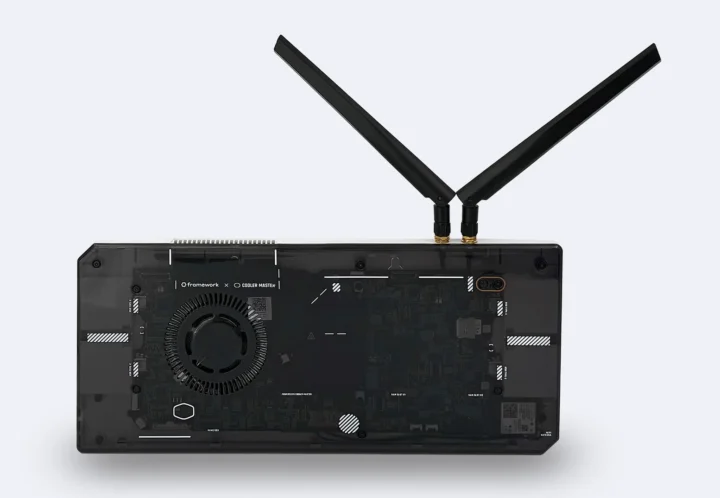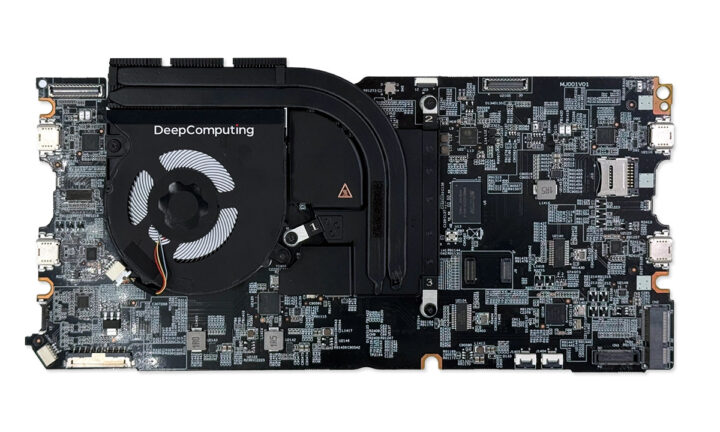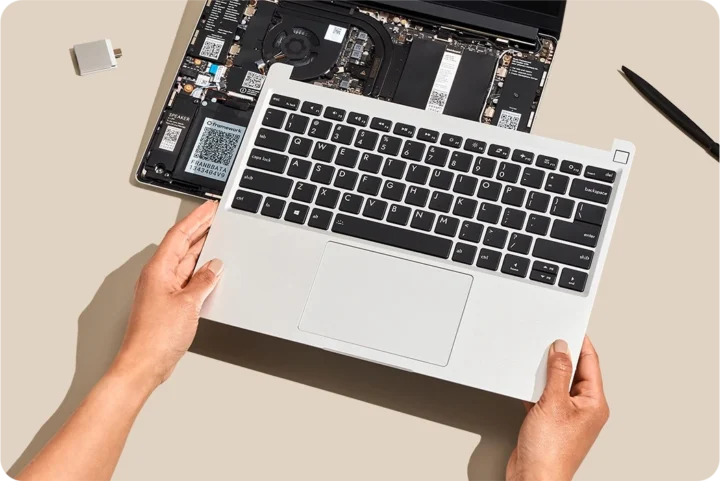DeepComputing’s DC-ROMA RISC-V Mainboard is designed for the modular Framework Laptop 13 and powered by a StarFive JH7110 quad-core RISC-V processor running either Ubuntu 24.04 Desktop or Fedora 41 Linux distribution.
The Framework Laptop 13 was initially offered with Intel Core i5-1135G7, Core i7-1165G7, or Core i7-1185G7 processor, but the advantage of a modular laptop is that you can replace components, and that’s exactly what the “DC-ROMA RISC-V Mainboard” does by allowing users/developers to do by switching to a less powerful RISC-V processor for software development.
Framework Laptop 13 specifications with DC-ROMA RISC-V Mainboard:
- SoC – StarFive JH7110
- CPU
- Quad-core 64-bit RISC-V SiFive U74 (RV64GC) processor @ up to 1.5 GHz with 32KB D-Cache, 32KB I-cache
- Single-core 64-bit RISC-V SiFive S7 (RV64IMAC) monitor core with 16KB I-cache, 8KB DTIM
- Single-core 32-bit RISC-V SiFive E24 (RV32IMFC) real-time control core with 16KB I-cache
- Up to 2MB L2 cache
- GPU – Imagination BXE-4-32 GPU with support for OpenCL 1.2, OpenGL ES 3.2, Vulkan 1.2
- Video Decoder – H.265, H.264 4K @ 60fps or 1080p @ 30fps, MJPEG
- Video Encoder – H.265/HEVC Encoder, 1080p @ 30fps
- CPU
- System Memory – 8GB
- Storage
- 64GB MicroSD card
- Optional socketed eMMC module
- Display – 13.5-inch display with 2256×1504 resolution, 60Hz refresh rate, 400nit brightness, and 100% sRGB color gamut
- Camera – 1080p60 webcam
- USB
- USB Type-C port with support for USB 3.2 Gen1 and USB 2.0, DP1.4 Alt. mode, USB PD 3.0 up to 60W
- USB Type-C port with support for USB 3.2 Gen1 and USB 2.0, USB PD 3.0 up to 60W
- 2x USB Type-C USB 3.2 Gen1/USB 2.0 ports
- Wireless – Intel Wi-Fi 6E and Bluetooth 5.3 AX210 module
- User input – QWERTY keyboard and touchpad
- Misc – Fingerprint reader
- Battery – 55Wh
- Dimensions – 296.63 x 228.98 x 15.85mm
- Weight – 1.3kg
The specifications did not mention the exact specifications, but Marta, a company representative, confirmed it was based on the StarFive JH7110 SoC found in other platforms such as the Geniatech XPI-7110 SBC, PineTab-V tablet, and Pine64 Star64 single board computer.
The company promises support for Ubuntu 24.04 Desktop and Fedora 41, but note that the RISC-V ecosystem is still a work in progress, and this type of hardware is mostly suitable for developers and enthusiasts. Besides getting a complete Framework Laptop 13, it’s also possible to get the board as part of a mini PC without a wireless module.

There are four tiers for the DC-ROMA RISC-V Mainboard:
- Basic – $199 and up – DC-ROMA RISC-V Mainboard, Framework & Cooler Master Case, 2x USB-C expansion cards, 64GB microSD card
- Standard – $299 and up – Basic + USB-A expansion card, HDMI expansion card, WiFi module, WiFi antenna
- Pro – $799 and up – DC-ROMA RISC-V Mainboard, Framework Laptop 13, 2x USB-C expansion cards, WiFi module, and 64GB microSD card
- Enterprise – $999 and up – Standard + Pro tiers
The RISC-V motherboard is not available to individuals yet and is only part of an “Early access program” open to enterprise and business customers only. You’re not even allowed to report your experience or review the unit without the companies’ authorization:
Any external sharing of user experiences of the Early Access Program must be approved by DeepComputing and Framework before publication.
So it’s pretty clear the samples sold now are Beta, or even Alpha units and they don’t want anybody to report about potential issues. Shipping fees and customs duties are not included, and samples are scheduled to be shipped within two weeks after ordering. More details may be found in the announcement.

Jean-Luc started CNX Software in 2010 as a part-time endeavor, before quitting his job as a software engineering manager, and starting to write daily news, and reviews full time later in 2011.
Support CNX Software! Donate via cryptocurrencies, become a Patron on Patreon, or purchase goods on Amazon or Aliexpress






